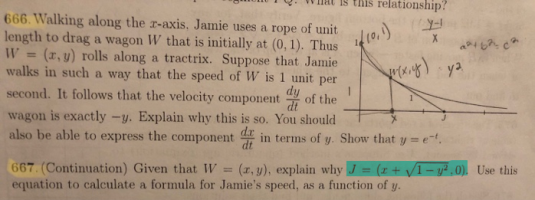I have spent a long time on problem #2, but I cannot figure it out. The answer key says the answer is 1/sqrt(1-y^2), but I have no idea how they got there. I originally thought that Jamie would just have a speed of sqrt(1-y^2), the same as the dx/dt for the wagon because they are attached. I also provided problem #1 for context. Thanks in advance!
#1:
Walking along the x-axis, Jamie uses a rope of unit length to drag a wagon W that is initially at (0, 1). Thus W = (x,y) rolls along a tractrix. Suppose that Jamie walks in such a way that the speed of W is 1 unit per second. It follows that the velocity component dy/dt of the wagon is exactly −y. Explain why this is so. You should also be able to express the component dx/dt in terms of y. Show that y = e^−t.
*I already solved this problem, but the info it provides is important for #674*
#2:
(Continuation) Given that W = (x, y), explain why J = (x + 1/sqrt(1-y^2) , 0). Use this
equation to calculate a formula for Jamie’s speed, as a function of y.
#1:
Walking along the x-axis, Jamie uses a rope of unit length to drag a wagon W that is initially at (0, 1). Thus W = (x,y) rolls along a tractrix. Suppose that Jamie walks in such a way that the speed of W is 1 unit per second. It follows that the velocity component dy/dt of the wagon is exactly −y. Explain why this is so. You should also be able to express the component dx/dt in terms of y. Show that y = e^−t.
*I already solved this problem, but the info it provides is important for #674*
#2:
(Continuation) Given that W = (x, y), explain why J = (x + 1/sqrt(1-y^2) , 0). Use this
equation to calculate a formula for Jamie’s speed, as a function of y.




